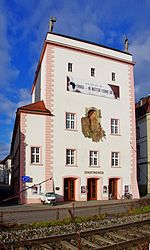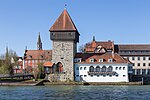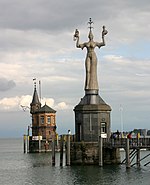Old Rhine Bridge (Konstanz)
Bridges in Baden-WürttembergBridges over the Rhine

The Old Rhine Bridge at Konstanz spans the Seerhein. It is a combined road and railway bridge. In addition to one track of the High Rhine Railway at kilometer 413.5, it carries the Konzilstraße, the road that connects the borough of Petershausen with the city centre. The road bridge carries two lanes into the city center and three lanes in the other direction. Additionally, there is a bicycle lane in both directions on the left (as seen from the city centre) and a sidewalk on the right. In the 19th century, distance markers were placed along the Rhine; they start counting kilometers at this bridge.
Excerpt from the Wikipedia article Old Rhine Bridge (Konstanz) (License: CC BY-SA 3.0, Authors, Images).Old Rhine Bridge (Konstanz)
Konzilstraße, Verwaltungsgemeinschaft Konstanz
Geographical coordinates (GPS) Address External links Nearby Places Show on map
Geographical coordinates (GPS)
| Latitude | Longitude |
|---|---|
| N 47.6662 ° | E 9.1786 ° |
Address
Alte Rheinbrücke
Konzilstraße
78462 Verwaltungsgemeinschaft Konstanz, Konstanz-Altstadt
Baden-Württemberg, Germany
Open on Google Maps








